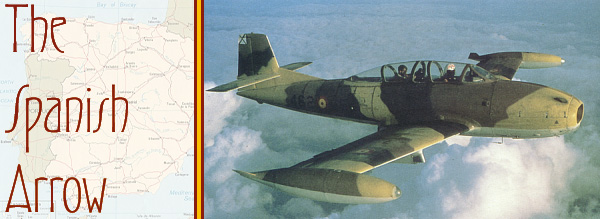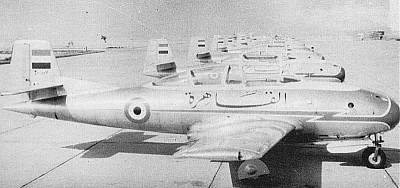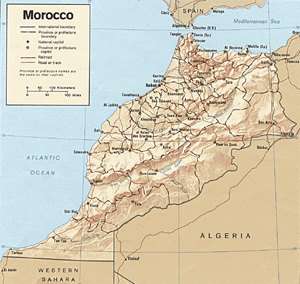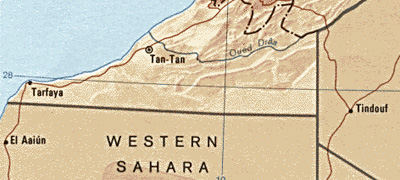This site is best
viewed at 800x600
and 16 bit color.

By Chris Banyai-Riepl
Spain has had a long history of aviation, but it wasn’t until the late 1950’s that they had a plane designed and manufactured at home. Much of the influence of Spanish design came from an influx of German scientists and engineers right after WWII, including Professor Willy Messerschmitt. Messerschmitt was put in charge of the Hispano design office and work immediately began on a piston-engined trainer. This design soon came to a halt, though, as US-supplied T-6s were brought in cheaply and in abundance. The Hispano design office then switched to a jet trainer that could also act as a COIN aircraft. This last part was essential, as the US MDAP aircraft such as the F-86 could not be used in the conflicts in Morocco or the Spanish African territories.
Based much on the previous piston-engined design, the HA-200 first flew on August 12, 1955. The design layout featured a straight wing with the fuselage housing two Turboméca Marboré engines. The engines were placed side by side, with the intake in the nose and the exhaust coming out at the trailing edge of the wing root. This maintained the center of gravity of the piston-engined design, and as such, very little redesigning needed to be done. The testing of the airplane was uneventful, and in 1957, a pre-production batch of 10 was ordered. This was quickly filled, and followed on by an order for 25 HA-200As. The HA-200As were fitted with two Breda 7.7mm machine guns in the nose and replaced the T-6G in the advanced and weapons trainer role.
Foreign interest in the HA-200 came from Egypt early on in the design. Egypt wanted to start its own indigenous aircraft industry, and the HA-200 was viewed as a great example to learn the practice of aircraft assembly. A license to produce the HA-200 was quickly acquired, and the new model was designated the HA-200B. It differed from the HA-200A in that it replaced the machine guns in the nose with a pair of 20mm cannons, added hardpoints to the wings, and used more powerful engines. A total of 63 were built in Egypt and five in Spain, bringing the total production run of the HA-200B to 68. Little is known of the operations of the Egyptian Arrows, but it is believed that some took part in the Six-Day War in 1967.

Egyptian HA-200Bs.
HA-200 service in Spain is somewhat better documented, and the Arrow distinguished itself quite well in Northern Africa. In 1970, the C.10Bs replaced the aging CASA-built Heinkel He 111s of Esc 462 on the Canary Islands, and from then on several C.10Bs flew on detachments to Spanish Sahara. These detachments were pressed into use during the Polisario uprisings in 1974-75. The first combat mission of the C.10B occurred late in 1974, when Polisario guerrillas ambushed a police patrol. Firing on the patrol from high ground and protected by caves, the Polisario troops effectively pinned down the police patrol and caused several casualties. First on the scene were T-6Ds armed with machine guns, and a couple of UH-1 helicopters outfitted as gunships. Their strafing runs were ineffective due to the cave structure the Polisario were hiding in, and as a result they pulled back and waited for the first Arrows to arrive. The first two C.10Bs showed up quickly and went to work. Equipped with 2.75" FFARs, they made diving rocket attacks on the cave. Coming in at a 45-degree angle, they fired their rockets, and on pulling up, they were able to observe the rockets flying straight into the caves. After these initial attacks, Legion troops advanced in the darkness to take the position, but return fire was heavy and several Legion troops were wounded, with one sergeant being killed. It was very apparent that there were more Polisario troops than originally thought.
As dawn approached, the C.10Bs arrived again, in the company of more T-6s and UH-1 helicopters carrying troops. The Saetas quickly lined up in their attack patterns and began their rocket attacks. The extreme precision seen the day before continued on this day, with rocket after rocket going into the caves. With a FAC calling the shots in where they were most needed, several large explosions were seen, most likely when a rocket set off some mortar rounds. After several of these passes, the troops initiated a sweep of the area and encountered hardly any resistance, with most of the guerrilla forces being destroyed by the C.10B rocket attacks. The stability of the C.10B was readily apparent in this first blooding of the airframe, with the pilots being able to put their rounds right on target, with very little variation. The cave entrances that they were aiming at were only about 5-10ft across, and very few rockets missed their mark.

General overview map of Morocco.
Conflicts with Morocco also called upon the Saeta for support missions, and it performed well there, even against the latest in Russian hardware. With the great stability of the C.10B and good maneuverability, the Saeta quickly showed itself to be a survivor. On one mission, two C.10Bs were returning to base when they spotted some troops on the wrong side of the border. When they went down to investigate, they saw two plumes of smoke, denoting the launch of a pair of shoulder-mounted SAMs. Quickly identifying them as SA-7 Strellas, the two C.10Bs rapidly broke into a high-G turn and broke for the deck, pulling up just above the ground. The two missiles passed slightly above and to the right of the two Saetas, missing both. The two planes then turned around and attacked the vehicles out of the sun, leaving two burning wrecks and several dead. Tensions between Morocco and Spain remained fairly high, and at the time of the "Green March", a plan for a commando assault on the Spanish air base at El Aaiun was discovered. C.10Bs then started training for the air-to-air role, practicing against helicopters and transports. When the assault came down, their mission would be to go after the commando helicopters and the C-119 transports, while the SF-5As would provide top cover. The "Green March" came, and instead of a military assault, a diplomatic one was undertaken, with the result of the Sahara territory being handed over to Morocco.

Close-up of the operating area of the Spanish Saetas.
This marked the end of hostilities with Morocco, and the Saetas were rapidly withdrawn to Spain, where they were transferred to different squadrons, with the most of them going to the Air Academy for training purposes. The stability of the Saeta made it a wonderful plane for training, with many pilots going through the courses in the C.10. But the Saeta was starting to show its age. With the new CASA 101 Aviojet coming out in 1980, the Saeta’s days were numbered, and by 1981, all of the Hispano aircraft were gone. The final ceremony for the Hispano HA-200 Saeta took place on January 23rd, 1982, when a formal dedication ceremony took place at Morón for the new gate guardian, an A.10B in the markings of 214-52.
As Spain’s first home-grown jet design, the HA-200 was exceptional. Not only was in incredibly stable in flight, but the construction was simple enough for a foreign country to want to license it in order to learn how to build aircraft. With the wide variety of COIN and trainer aircraft available at the time, the Hispano HA-200 Saeta has to rank right up near the top of the list, and this first step by Spain paved the way for a future aircraft industry.
Air Enthusiast, Number 24, Pilot Press, Ltd, 1984.
World Military Aviation, Nikolaus Krivinyi, Arco Publishing, 1977.